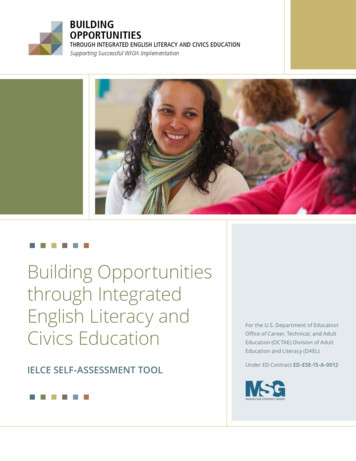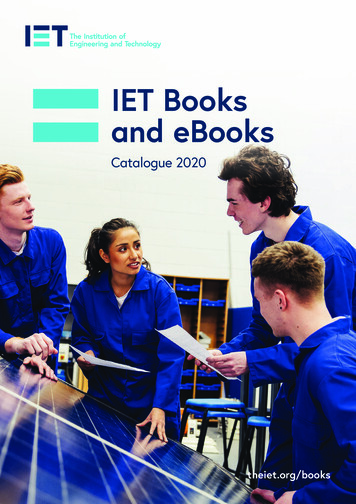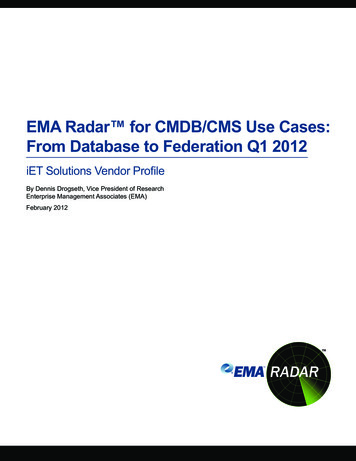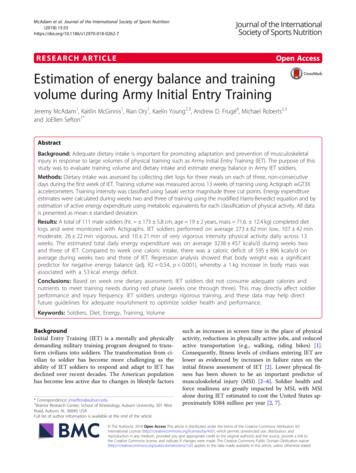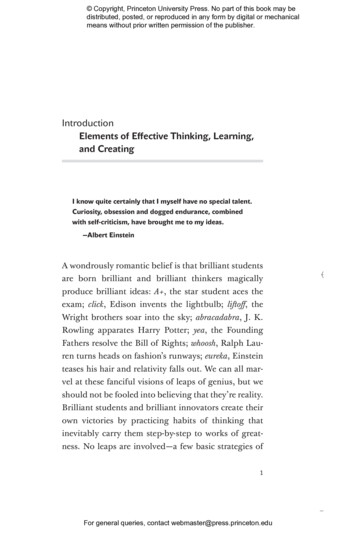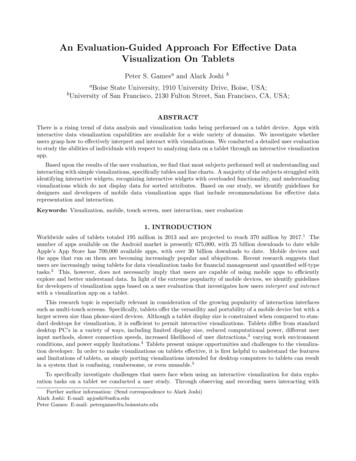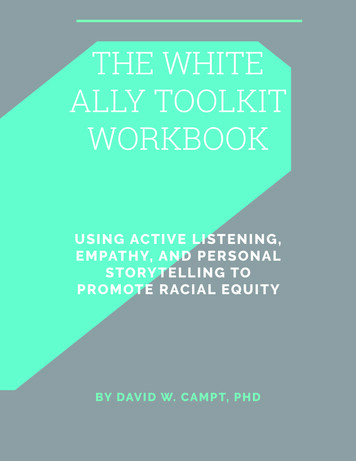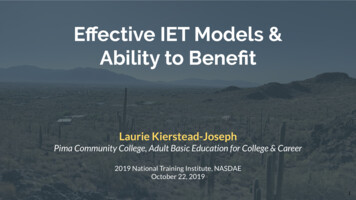
Transcription
Effective IET Models &Ability to BenefitLaurie Kierstead-JosephPima Community College, Adult Basic Education for College & Career2019 National Training Institute, NASDAEOctober 22, 20191
Lessons learned in implementingIETs at a variety of levelsGoals Successes and challenges withutilizing Ability to Benefit Strategies for partnershipdevelopment Infrastructure and trainingneeded to support IETdevelopment and implementation2
Our ContextTucson, Arizona3
4
ABEIndustryWIOAOne StopSystemPCC/CTE5
Getting Started with IETs: IBEST6
IETAdult Education and Literacy Workforce Preparation Workforce Training7
3XIntegrated BasicEducation &Skills Trainingmore likely to earn college credit9Xmore likely to complete a credentialwww.sbctc.edu8
Traditional instructional model vs. IBESTGEDBasic Skills ClassesBasic Skills InstructionOccupational CertificateSTARTCAREER!Technical Content InstructionGEDIBESTSTARTCAREER!Basic skills instruction Technical content Instruction together9
Our IBEST ModelHotel & RestaurantManagementMedical AssistantMachine Tool TechnologyLogistics & Supply ChainManagementBehavioral Health ServicesAutomated IndustrialTechnology For higher level studentsAE CTE instructorsBlended GED and non-GEDCohort model 1 yearPartner with college certificateprograms; Industry-recognizedcredentials built-inATB-eligibleStudents co-enroll with One StopIn AZ the GED is the primary way toget an HSE10
Braided FundingBasic Skills & Workforce PrepWIOA Title II & Local College FundsCTE InstructionLocal College FundsTuition & FeesWIOA Title I & Federal Financial AidWraparound SupportsWIOA Title I & Local College Funds11
IBEST Outcomes High completion rates 81% of completers employed, 54%employed in sector75% Strengthening collaboration withWIOA and CTE partnerscomplete postsecondarycertificate Fostering improvement in instructionand student services at our college12
Expanding Access: Ability to Benefit13
Ability to BenefitAllows students without a high school diploma to access Federal FinancialAid to pay for postsecondary education if: They are enrolled in a career pathway program; AND They have completed 6 credits toward a degree or certificate; OR They have passed a Department of Ed approved exam.14
ATBChallenges Had to convince FA office to get ATBstarted Lack of local funding for first 6credits means students must passtesting threshold Limited number of DOE approvedtests means students taking multipletests15
ATBSuccesses IBEST model easily fits “careerpathway program” definition CTE partners helped to get collegeFA office on board Leveraged WIOA Title I funding,when possible, to pay for first 6credits16
ATB: Outcomes 46% of current GED-seeking cohort utilized ATB ATB recipients complete post-secondary certificate at equalor slightly higher rates than both high school graduates inIBEST and GED-seekers not utilizing ATB in IBEST17
Reaching More Students: Early IBEST18
IBESTEarly IBEST Adult Ed & Non-Adult Ed students Adult Ed students only College Certificate No College Certificate Industry-recognized credential Industry-recognized training/credential Highest level students Intermediate to higher level students Up to 1 year long, cohort Less than 1 year. As short as 9 weeks long At a college campus At a learning center Must earn GED during program Not expected to earn GED during program Contextualized instruction to career Contextualized instruction to career Employability Skills Portfolio Employability Skills Portfolio (short) Co-enrollment at One Stop part of intake Co-enrollment at One Stop during program19
Early IBEST:What do these programs look DING &CONSTRUCTION20
Early IBEST for Caregiving9 weeks4 weeks contextualized Adult Education2.5 weeks Caregiver training2 weeks Adult Education employment readiness21
Partner: ExternalHow we found partner: Through HPOGInstruction: Contextualized andco-taught 4 4 1Class: ABE (NRS3 ) and ELAA070Industry recognized credential: AZState Caregivers ExamEarly IBEST forCaregivingTraining: Intensive Caregiver Trainingvia CGTI22
Early IBEST for Computer Science1 semester4 mornings/week 8-9amFridays 9am-11am23
Partner: External (Microsoft PhilanthropiesTEALS), University of ArizonaEarly IBEST forComputer Science(TEALS)How we found partner: Through OneStopInstruction: Remote instruction by industryprofessional. In-person support from UAstudent volunteersClass: ABE (NRS3-4 ) and ELAA070Early IBEST forComputer ScienceTraining: Students learn to code withPython. No industry recognized credential24
Early IBEST for Entrepreneurship9 weeks2 mornings/week 9am-12pm
Partner: Multiple community and collegeconnections. Internal course designHow we found partner: Used personal andcollege networks and community programsClass: ELAA 070 studentsInstruction: Focused entirely onentrepreneurshipTraining: Entrepreneurship and BusinessPlan DevelopmentEarly IBEST forEntrepreneurship26
Early IBEST for Building andConstruction9 weeks2 afternoons/week 12pm-3pm27
Partner: PCC BCT facultyHow we found partner: Housed in ourcollegeInstruction: taught by AE instructor,curriculum informed by BCT facultyClass: ABE (NRS3 ) and ELAA070Training: Contextualized curriculum leads toNCCER micro-credentials; OSHA10Early IBEST for Buildingand ConstructionTechnologies28
EMPLOYMENT AS MAEarly IBEST forCaregivingMedical Assistant IBESTFurther training or academic pursuits(LPN, Radiology, Public Health, etc.)EMPLOYMENT IN BCTEarly IBEST forBuilding/ConstructionAutomated IndustrialTechnology IBESTEarly IBEST forComputer Science orEntrepreneurshipLogistics and Supply ChainManagement IBESTFurther training or academic pursuits(Electrician, Solar, Welding, etc.)EMPLOYMENT IN LOGISTICSFurther training or academic pursuits(2 2 with NAU, Business, ComputerScience, etc.)29
72%Average hours per studentMSGs on NRS Table 424230
What supports and infrastructureare needed?31
CollaborationDevelopment Leadership: High-level supportand buy-in from all partners Training: In collaboration andteam-teaching Roles: Agreement and clarityabout goals and roles32
Buy-In Training: Train leadership Data: Share the outcome data Partner: Start with a programthat has a need we can meet Visibility: Celebrate and shareevery success33
IET Team Coordination: Dedicated IETManager Teaching: Dedicated educators;train in team teaching Support Services: Dedicatedstudent services staff34
Flexibility Fit: Program needs to fit thestudents, context, community Time: Collaborative IETdevelopment takes lots of time Career Training: Think outsidepostsecondary box for Early IBEST Change: Programs and localemployability can change overtime; be ready to pivot35
Questions?Laurie Kierstead-Josephlkierstead@pima.edu36
ResourcesIBEST/IET Webinar - I-Better: Success and Lessons Learned through Implementing I-BEST Programs Washington State ices/i-best/ Columbia University,- Community College Research Center http://ccrc.tc.columbia.edu NCTN Team-Teaching Course tml Accelerating Opportunity unity National Career Pathways Network www.ncpn.info CLASP https://www.clasp.org/ COABE https://coabe.org/37
ResourcesATB U.S. DOE teria https://ifap.ed.gov/dpcletters/GEN1509.html areerPathwayProgQandA.html https://ifap.ed.gov/dpcletters/GEN1609.htmlCLASP lementation-Guide.pdf38
Partner: PCC BCT faculty How we found partner: Housed in our college Instruction: taught by AE instructor, curriculum informed by BCT faculty Class: ABE (NRS3 ) and ELAA070 Training: Contextualized curriculum leads to NCCER micro-credentials; OSHA10 28
